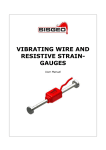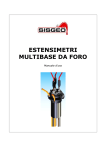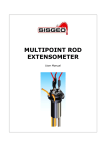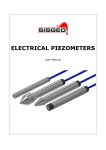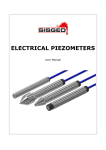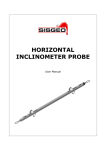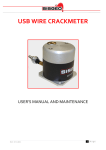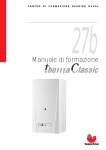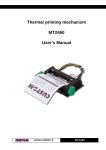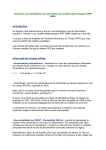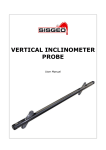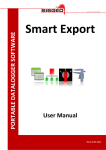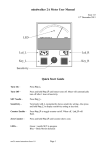Download _ H-LEVEL - SISGEO North America
Transcript
_ H-LEVEL monitoring system USER MANUAL www.sisgeo.com H-LEVEL_EN_00_14 Page 1 of 16 H-LEVEL INDEX www.sisgeo.com IntroduCTION Page 4 Description Page 5 preliminary checks Page 6 INSTALLAtion Page 7 TAKING MEASUREMENTS Page 13 DATA MANAGEMENT Page 13 Troubleshooting Page 14 MAINTENANCE Page 15 APPENDIX Page 16 H-LEVEL_EN_00_14 Page 2 of 16 H-LEVEL Notes on the use of product For safe and efficient use of the product, please read carefully the following instructions before starting any operation. Any use of the product other than the one described in this manual shall be considered the user’s full responsibility. The same applies for any unauthorized modifications. In addition to the hereby listed standards, the user must comply with the provisions of the current legislation regarding personal safety and health together with all other persons in the workplace. SISGEO is not responsible for any accident, breakdown or other problems due to lack of knowledge and / or non-compliance with the requirements contained in this manual. Check that the product has not been damaged during the transport. Verify that the package includes all items as well as any requested optional accessories; if anything is missing, please promptly contact SISGEO. The user must strictly follow all the operations described in this manual. Maintenance or repair of the device is permitted only by authorized operators. These operators must be physically and intellectually suitable. For information about instrument or to order spare parts, always specify the product information which can be found on the identification label. When replacing parts, always use ORIGINAL SPARE PARTS. The manufacturer reserves the right to make either technical and / or commercial changes without prior notice. It is our policy to keep manuals continuously updated. Symbols Pay particular attention to the following instruction. Identification www.sisgeo.com Instruments can be identified • From a production lot number (written on the Compliance Certificate) • From a serial number (s/n) engraved indelibly on the instrument • From a label on the instrument • From a label on the cable H-LEVEL_EN_00_14 Page 3 of 16 H-LEVEL INTRODUCTION H-level settlement gauges are used to monitor subsidences and/or settlements in buildings and structures. An H-level system is composed by a reference tank, placed out of the area that has to be monitored, and by one or more settlement gauge based on pressure transducer. The settlement gauges are placed in the points of interest and are connected through two flexible tubes. One tube contains the liquid, the other is necessary for the barometric compensation, which is common to all the settlement gauges . During the plant design phase, we suggest to install a settlement gauge near the tank (in a stable zone not subject to settlements) in order to have some measurements to compare to the other settlement gauges. The vertical movement of a settlement gauge modifies the level of the head between the tank and the settlement gauge, creating a pressure variation. It is possible, on request and for particular applications, to ask for the horizontal installation of the settlement gauge. www.sisgeo.com H-LEVEL_EN_00_14 Page 4 of 16 H-LEVEL DESCRIPTION The H-LEVEL settlement gauge consists of: 2 4 6 1 1. Settlement gauge; 2. hydraulic tube connectors Ø 10/12 mm; 3. barometric compensation tube connectors Ø 6/8 mm; 4. drain valve; 5. fixing plate; 6. plugs (hole Ø 12mm); 7. connector. 3 5 7 The tank consists in: 5 7 2 6 4 1 1. Measure tank (lower part); 2. autofilling tank (upper part); 3. hydraulic tube connector Ø10/12mm; 4. water level control; 5. air filtering and drying system on tubes for barometric compensation; 6. plugs; 7. cap. In the packaging there are also circuit closure caps (to be installed in the last settlement gauge of the circuit). 3 www.sisgeo.com H-LEVEL_EN_00_14 Page 5 of 16 H-LEVEL Usually the liquid used is a water-glycerine mix (50% water, 50% glycerine). This mix has been chosen for its high temperature range without substantial changings in physical features, to its low gas tension and for the lack of seaweeds and mould formation. In addition, it is also chemically inert to the materials composing the system and environmentally non-dangerous. The medium density is 1.1555 g/cm3 . The saturator is an optional accessory used to fill the circuit. It consists in: 5 4 2 3 1. A stainless steel container of Ø250mm and about 20l. capacity; 2. a valve for Ø 6/8 tube; 3. a valve for Ø 10/12 tube; 4. manometer; 5. compressor connection; It is combined with a portable compressor with rechargeable battery. 1 PRELIMINARY CHECKS www.sisgeo.com Useful tools: • Spanner n° 12 e 18 • Screwdriver • Allen key n° 5,10 • Drill and tips of Ø 9 and 12mm suited for the material to be drilled • Cutter • Bucket • Rags • Funnels • Raceways with plugs for fixing tubes and cable H-LEVEL_EN_00_14 Page 6 of 16 H-LEVEL INSTALLATION Connectors wiring The electrical cable to be connected to the instrument generally has already a connector on one side. On request, it is possible to supply a cable reel from which it is possible to cut the single parts. In this case, it is necessary to wire the connectors as follows: PINS FUNCTION N° 1 +Loop N° 2 Thermistor N° 3 Thermistor N° 4 - Loop N° 5 Shield Precautions and suggestions Verify the correct functioning of every sensors before starting the installation. The value you read without pressure is around 4mA. If installed outside, provide a roofing in order to supply some repair from the bad weather conditions. The settlement gauges have to be installed at the same height and below the level of the tank without exceeding the range of the settlement gauge. Consider also the expected settlements. ~120mm <Sensor Full scale If insulation is used, it is necessary to cover the whole circuit, also near the settlement gauge. Use suitable insulation foams. www.sisgeo.com H-LEVEL_EN_00_14 Page 7 of 16 H-LEVEL Settlement gauge installation 4 2 3 1 www.sisgeo.com • • • Fix the instrument with the supplied plugs (1). Hole Ø12 mm; fit the 4 tubes on their connectors and screw the sleeves (2); to help the drain, we suggest to fix the tubes (3) on the wall in order to keep them below the connector (see picture below); • • ensure that the drain valve is closed (4); arrange a container to receive the liquid that drains from the last settlement gauge. H-LEVEL_EN_00_14 Page 8 of 16 H-LEVEL Tank installation • • 3 5 • • 2 6 • • Fix the tank with the 4 plugs supplied (1). (Hole Ø12mm); connect the filter system (3) to the tank using the 6/8 tube that is ca. 20cm long (2) and fix it to the wall higher than the tank. (Hole Ø9mm); close the valve (4); remove the cap (5) and fill in the tank using a funnel and cheking the water level control (6). (the volume is approximately 7l.); close the cap (5); keep the valve closed (4). 1 4 7 Filling of the circuit It’s possible to fill in the circuit in two ways: • using gravity (for short circuits of 15/20m) • using the saturator. Note: Approximately, you need about 8 l. x 100 m. Using gravity • • • • • • • • www.sisgeo.com Close the valve (7); use a suitable container and connect it to the valve (7); put the container at a level that allows to fill in the circuit. Do not exceed 10m. head; open the valve (7); drain the liquid from the last settlement gauge; when the whole circuit is filled, and there are no air bubbles, close the connector with the cap supplied (see next paragraph); close the valve (7) and disconnect the container; drain the settlement gauge as explained next. H-LEVEL_EN_00_14 Page 9 of 16 H-LEVEL Using the saturator 3 1 2 Open both valves (1-2). Remove the plastic cap (3). 4 2 1 Fill the tank using a funnel (4) with the mix necessary to fill the whole circuit. It is important to fill the circuit in a single time. Close the valves (1-2) and connect the compressor. Turn on the compressor (5) and reach a pressure of about 4 bar. Do not disconnect the compressor. 5 www.sisgeo.com H-LEVEL_EN_00_14 Page 10 of 16 H-LEVEL 5 6 Open carefully the valve (2). Do not exceed 1 bar of output pressure (8). Attention: a pressure too high could irremediably damage the settlement gauges. 2 7 Put the saturator with the valves upside down. Connect the saturator to the tank (6) using the 10/12 tube (7). 8 Let the liquid drain from the last settlement gauge (9) to eliminate any air bubbles within the circuit. 9 Put the supplied cap on the last settlement gauge (10) and close the valve (2) of the saturator. 2 10 During the closure of the last settlement gauge, close the tank valve (11). Disconnect the saturator from the tank (6). 6 2 11 www.sisgeo.com H-LEVEL_EN_00_14 Page 11 of 16 H-LEVEL Open the tank valve (12) and let the tank liquid touch the settlement gauges. Open for 2 second the valve (11) to drain air. Pay attention to the liquid spill. 12 11 13 Open the drain valve (13) for 2/3 second and close it immediately. Repeat this operation for every settlement gauge. Read each settlement gauge and verify that they are in the required value. If necessary, move them up or down. Tank auto-filling The tank has an auto-filling system, that allows the liquid level to remain stable also in case of little leaks in the circuit. This example shows how to notice the spills analyzing the data. This behaviour will be registered on all settlement gauges and will be necessary to find and fix the leak on the circuit. www.sisgeo.com H-LEVEL_EN_00_14 Page 12 of 16 H-LEVEL TAKING MEASUREMENTS Manual readings are taken connecting the conductors to a readout according to the following scheme: Sensors with 4-20 mA signal current loop COLOUR FUNCTION PINS Red +Loop 1 Black - Loop 4 White Thermistor 2 Green Thermistor 3 Shield Shield 5 To obtain reliable measures we recommend a warm up time not less than 10 seconds. DATA MANAGEMENT The following formulas allow to convert the electric measurements into engineering values: Linear factor Polynomial factor Leng = Lele/S [mm H2O] Leng = (Lele2 x A) + (Lele x B) + C [mm H2O] Leng = Engineering unit Lele = Electric unit S = linear sensitivity factor A, B, C = polynomial conversion factors S, A, B, C are stated on Calibration Report. The excercise readings refer to the initial reading (zero reading). ∆mm H2O = Li - L0 L0 = Zero reading [mm H2O] Li = Excercise reading [mm H2O] Zero reading shall be taken carefully once the installation is performed and the instrument is in operating conditions. For many applications is necessary to wait several days to obtain a reliable zero reading. We suggest to take the readings in a short lapse of time to verify if the system is stable. Note: in case the liquid used is a mix of 50% water and glycerine, the obtained values in mm must be divided for 1,1555. Please consider what is written in the introduction paragraph on the way to connect data. www.sisgeo.com H-LEVEL_EN_00_14 Page 13 of 16 H-LEVEL Temperature measure With a Sisgeo readout, the temperature is taken directly in °C. If you measure thermistore resistance value, you have to convert it using the formula or the table in Appendix 1. Data analysis note Generally speaking, but especially when there are complex circuits, it is necessary to use a statistical approach to analyze the data and cancel any temperature effect on the measures. Problem Overrange measure OmA measure Unstable measure TROUBLESHOOTING www.sisgeo.com Possible cause Solution Shield not connected Connect the shield Electro-magnetic fields nearby (engines, generators, radio antennas, welders, high voltage lines...) Identify and remove the cause. Data acquisition system grounding not Provide efficient grounding well done. Open circuit Make a correct connection Wrong connection Make a correct connection High absorption Fix critical point Short circuit Fix critical point H-LEVEL_EN_00_14 Page 14 of 16 H-LEVEL MAINTENANCE Check periodically the hygroscopic salts status in the air filter system and change them when 50% is shown. Check for leaks in the tubes. In case of cuts, we recommend to use joints connectors (see photo below) MAINTENANCE SERVICE After-sales assistance for calibrations, maintenance and repairs, is performed by SISGEO’s service department. The authorization for shipment shall be activated by RMA “Return Manufacturer Authorization”. Create your account and then fill in the RMA module clicking on: http://www.sisgeo.com/repairs.html Send back the instrument/equipment with the complete accessories, using suitable packaging, or, even better, the original ones. The shipping costs shall be covered by the sender. Please return to the following address with correct delivery documentation: SISGEO S.r.l. Via F.Serpero, 4/F1 20060 MASATE (MI) On the delivery document it is mandatory to indicate the RMA code received. Technical assistance e-mail: [email protected] www.sisgeo.com H-LEVEL_EN_00_14 Page 15 of 16 H-LEVEL APPENDIX 1 THERMISTOR TEMPERATURE CONVERSION Resistance to temperature equation: 1 T= =273.2 A + B ( LnR ) + C ( LnR )3 Where: T= temperature in °C LnR= natural Log of the thermistor resistance A= 1.4051x10-3 (coefficents calculated over the -50 to +70°C span) B= 2.369x10-4 C=1.019x10-7 www.sisgeo.com Ohms Temp Ohms Temp Ohms Temp Ohms Temp 16.60K -10 5971 10 2417 30 1081 50 15.72K -9 5692 11 2317 31 1040 51 14.90K -8 5427 12 2221 32 1002 52 14.12K -7 5177 13 2130 33 965.0 53 13.39K -6 4939 14 2042 34 929.6 54 12.70K -5 4714 15 1959 35 895.8 55 12.05K -4 4500 16 1880 36 863.3 56 11.44K -3 4297 17 1805 37 832.2 57 10.86K -2 4105 18 1733 38 802.3 58 10.31K -1 3922 19 1664 39 773.7 59 9796 0 3784 20 1598 40 746.3 60 9310 -1 3583 21 1535 41 719.9 61 8851 2 3426 22 1475 42 694.7 62 8417 3 3277 23 1418 43 670.4 63 8006 4 3135 24 1363 44 647.1 64 7618 5 3000 25 1310 45 624.7 65 7252 6 2872 26 1260 46 603.3 66 6905 7 2750 27 1212 47 582.6 67 6576 8 2633 28 1167 48 562.8 68 6265 9 2523 29 1123 49 543.7 69 525.4 70 H-LEVEL_EN_00_14 Page 16 of 16

















